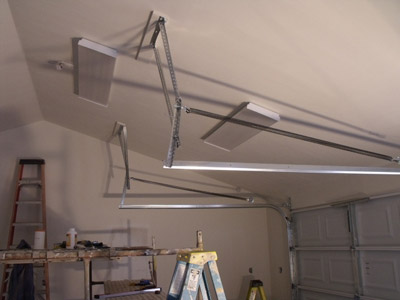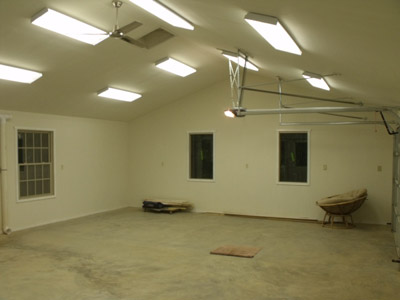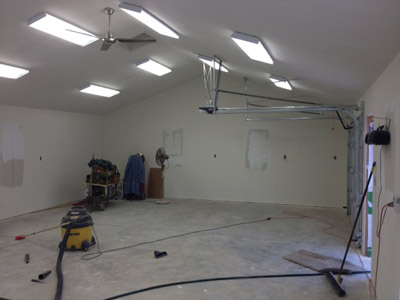My Last Shop: Part 8 - Construction Details Continued
by Michael Smith
Mountain Park, GA
Click on any picture to see a larger version.
Hello again, this is my eighth installment of my experience with building my last shop. To bring you up to speed I am a retired California high school woodshop teacher now living in Mountain Park, GA near my two grown children and their families. Not counting the woodshop where I taught this will be my fourth and last (probably) shop.
The insulation is stapled, wiring strung, and the sheetrock hung. Is this the home stretch? I don't think so. There is a lot more nidgey work to do. Siding, windows, finish electrical, doors, and paint. Then I'll be in the home stretch. The wifey asks me each day, "What did you get done today, Dear?" "Oh, I had a good day and got a bunch done," I say. She responds with, "You'll be able to start my table next week then?" Arrrrgh!
Siding
The house is sided with fiber cement lap siding, commonly called
Hardie Board
but there are other brands.
Nichiha
is the one I used. I've used both but for my money, Hardie Board is much friendlier to install. I searched YouTube for hints on installing this by myself and got some good ideas. You should always check YouTube if you are going to do something you've never done before. I'm not going to spend time talking about how to install fiber cement siding but there are four tools I think you absolutely must have. The first is a fiber cement blade to cut with. There is a lot of dust so use a mask also. I also set up a fan to blow the dust away. Second, set up sawhorses with a 2 x 12 x 12 foot plank to do your sawing on. Third, rent a coil nailer, if you don't have one. Last, Home Depot sells a tool called a Gecko Siding Gauge. At about $60.00 I think the price is a rip-off but I have to say that it makes putting the siding up a breeze, especially if you are working by yourself.
Windows
Remember that I said that I was a child of a child of the depression. Cheap is my middle name. I shopped several Habitat For Humanity ReStore stores here in the Atlanta area. These stores take in surplus building materials and resell them to fund Habitat for Humanity construction projects. I scored seven vinyl, insulated, double hung replacement windows for about $30.00 each. I couldn't find a single window for under $120.00 anywhere else. The downside was that I had to be careful of my rough opening sizes when we were framing. I ended up using just five of the windows but I think I can sell the two extras on Craigslist easily enough. By the way, I looked on Craigslist for windows but couldn't find enough that matched. Lastly, I made four fixed windows for the gable ends and bought single glass panes. All in all, I actually put in too many windows. Now I don't have much wall space for shelves and cabinets. More on that issue later.
Doors
The shop is basically a three car garage with two big doors at each end and a 3/0 door in the middle bay. For one end I built carriage type doors that swing out. My tablesaw is going in this bay and I didn't want a roll-up hanging overhead there to get in the way of my woodworking. I could have made the other door but in the interest of time (remember the wifey's honey-do list?) I thought I would just buy a roll-up door. Over the years I have installed four roll-up doors. Not easy but I did it. Just read the instructions, you can do it. In fact, the Home Depot website had reviews from people who installed the door in just a couple of hours. So I jumped on that. I'm not proud to say that it took me four days. Glurbb! It seems like I had problems all along. Part of what made it so hard was that my ceiling is not flat but has a 4/12 slope because of the scissor trusses that I used. The standard mounting hardware is just not strong enough to handle the strains of the door raising springs. I should have used bridge girders. It's done now. Four days and as many trips back to Home Depot to get more bracing hardware! She responds with, "You'll be able to start my table next week then?"

|

|
Finishing Electrical
I like this kind of work and it's rewarding to see your wiring boxes neatly made up. I have a few machines that run on 220 Volts and I put in circuits for them as well as two extra circuits for machines I don't have yet (and may never have at this rate). Someday, I would like to have a 220V air compressor and maybe a wide belt sander which could round out my tool inventory (Santa, are you listening?). Each wall has its own 120V circuit. The main panel is 200 Amp. I will make a big table to fit around my table saw to use as a workbench. It's the way I like to work. So I'm adding a receptacle under the table and one in the ceiling overhead. The receptacle under the saw is for my built-in router. The receptacle over head will power a pull down extension cord so I won't have to stretch cords over the floor. For air circulation there is an industrial ceiling fan in the center of the shop and a motel/hotel type heat pump as well. Looking back, I wish I had put a receptacle outside the doors and maybe one up under the eave for who knows what. Again, I want to bitch about the Tamper Proof receptacles I had to use. They are eating up my two pronged plugs. Slowly, I am converting the plugs to grounded three prongs.

|
Paint
What can I say about paint? The outside of the shop had to be the same color as the house so I couldn't do anything much with that. But for the interior I had a lot of latitude. What color do I care as long as it's light? "Doesn't have to be white," he says. So I scrounged up all of the pale paint from the house storage and then I went to Home Depot and Lowes to look for light colored mixing rejects. Save money! Live long and prosper.
Michael can be reached by email at
woodsmith@sonic.net
.
Return to
Wood News
front page


